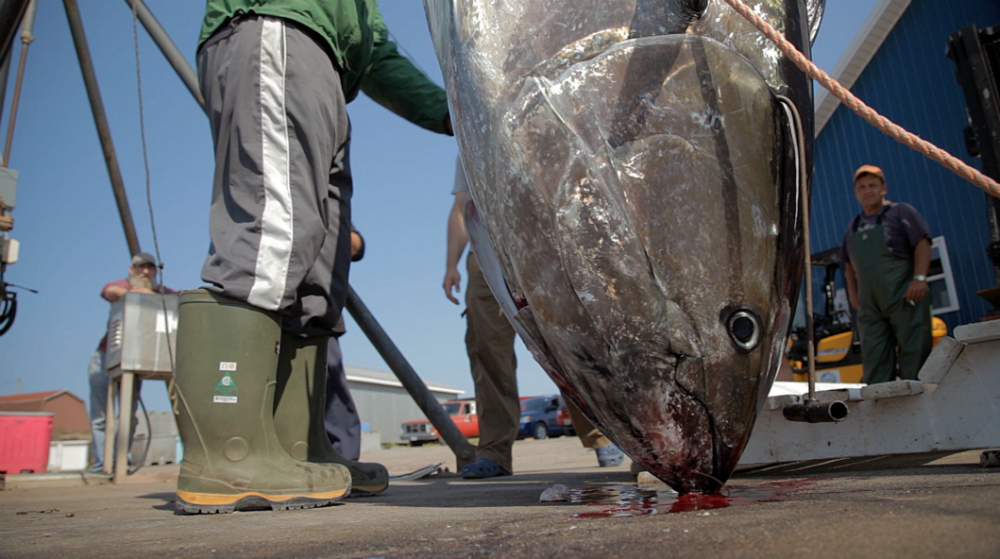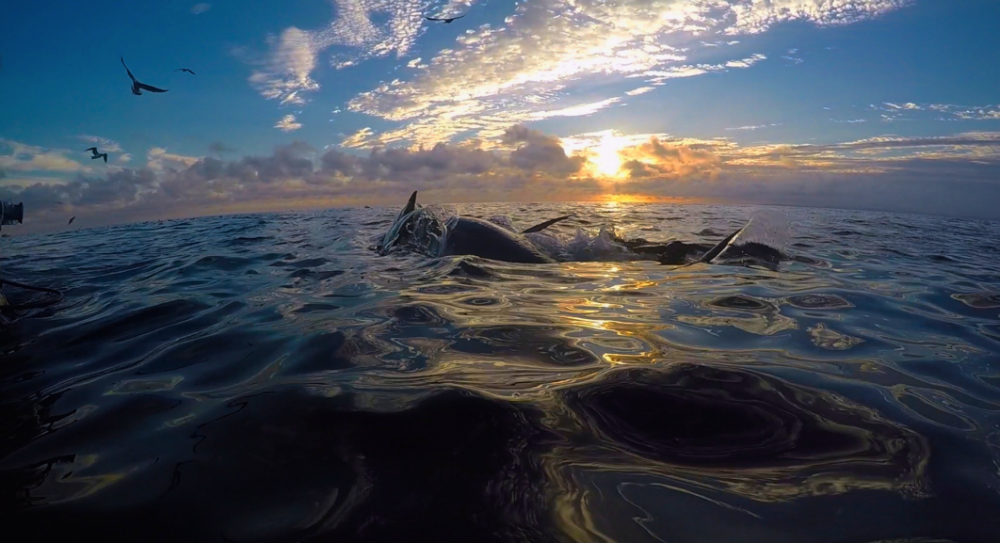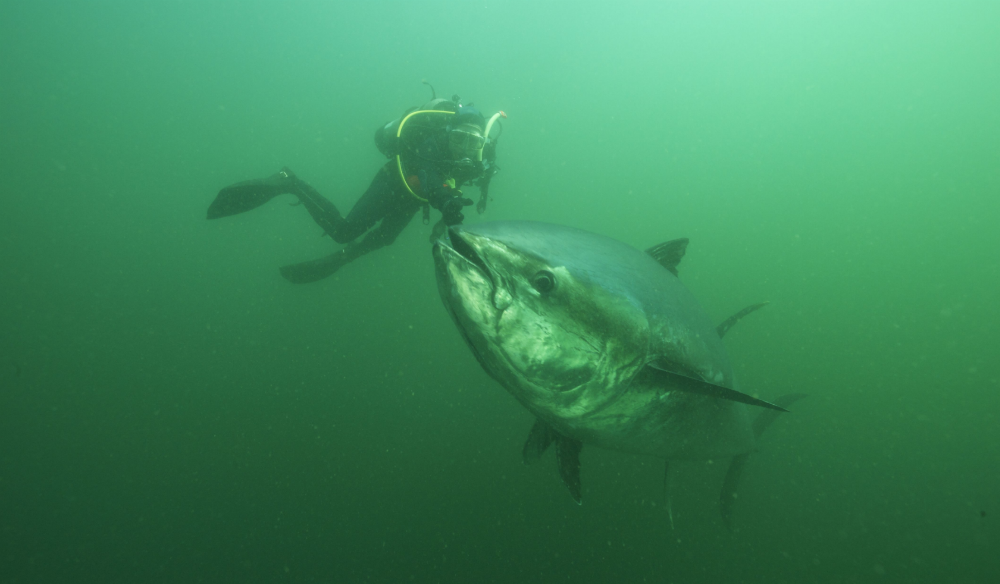Bobbing up and down on cold Atlantic waters, several fishermen toss scaly, silver mackerel overboard. It's a delicious snack for a bluefin tuna — the largest species of tuna in the world, measuring more than six feet in length and weighing up to 1,600 pounds.
The newcomer among them, a writer and ecologist, expects to spend the afternoon patiently waiting for a bite. Instead, the bluefin tuna here in North Lake, P.E.I. are so abundant and so hungry that within minutes their trademark yellow caudal finlets are circling the boat.
With a quick and audible snap, one surfaces just long enough to swallow the chum and glide over on its side, showing the fishermen its remarkable size. Sometimes, says one of the men, the bluefin are so hungry they'll take the bait straight out of a person's hands.
It's one of many up close and personal encounters captured in Bluefin, a new documentary by P.E.I. director and writer John Hopkins examining the mystery of North Lake's bluefin tuna. Some estimates indicate that more than 80 per cent of the world's Western Atlantic bluefin population has been wiped out from overfishing, yet in North Lake, known as the "Tuna Capital of the World," they swarm in massive numbers.
And they're always hungry, says Hopkins — so hungry, in fact, they've lost their fear of humans entirely and endanger themselves near fishing vessels for the chance to eat. Something strange is happening, he told National Observer, and it's causing major confusion in the case to conserve them: are Atlantic bluefin tuna on the rebound or not?
Bluefin is a 52-minute documentary by P.E.I. director John Hopkins of Square Deal Productions. The film is scheduled for screening at the Hot Docs Ted Rogers Cinema in Toronto, which programs year-round, on Dec. 19, 2017.
A dangerous and deceptive decline
North Lake, a small 'unincorporated area' in eastern P.E.I., is a migratory stop for Western Atlantic bluefin, which travel north from the Gulf of Mexico where they spawn. When the commercial fishery for P.E.I.'s bluefins took off in the 1960s and 70s — almost exclusively to feed Japan's insatiable sushi market — their numbers dropped dangerously low.
In Japan, Bluefin reveals, a single fish can sell for US$10,000 and roughly 10,000 metric tonnes of bluefin are sold each week in the Tsukiji Market in Tokyo. There isn't much of a market for them in Canada, said Hopkins, where bluefin have traditionally been considered too oily to eat and too much trouble to prepare.
While migration brings bluefin to North Lake, so does the concentration of easy prey: fishermen are constantly reeling in schools of herring to serve as bait in their lobster traps.
The problem now, said Hopkins, is that the herring stock in North Lake has decreased so dramatically that it leaves piles of hungry bluefin swimming in local waters. That's what gives local fishermen the impression that they're abundant, he explained, masking a global population well below where it used to be.
There's also evidence that Eastern Atlantic bluefin have been mixing in the water with Western populations off the East Coast, according to Fisheries and Oceans Canada (DFO), contributing to the influx of bluefin in the area.
"Normally, they're vary wary fish and would be frightened to go near fishermen, like they have traditionally in the past," said Hopkins. "But these guys are coming right up to the boat looking to be hand-fed like pets, because it's basically the only survival route that they have at this moment.
"Fishermen are surprised that the fish are so friendly, but no one's putting two and two together."

Bluefins not endangered: DFO
According to DFO, Canada's Western Atlantic bluefin tuna fishery attracts more than 750 licensed harvesters, who earn roughly $10 million a year. The fish are caught over the Scotian Shelf, in the Gulf of St. Lawrence, in the Bay of Fundy and off the coast of Newfoundland and Labrador.
The federal government is a "strong advocate" for their conservation using precautionary approaches to stock management, says DFO's website, but in 2016, the department rejected recommendations from the Committee on the Status of Endangered Wildlife in Canada to list the fish as an endangered species. At the time, it noted, stocks had been rebuilding since 2011, and nearly 650 commercial licenses and 57 sport fishing charter operations in Atlantic Canada would face "significant socioeconomic cost" by a species-at-risk designation.
Asked about that decision, in a written statement on Friday, DFO said it "decided to not list given domestic and international management regimes in place, and projected socio-economic impacts."
The stocks have indeed improved over the last decade, said Gary Melvin, a research scientist with DFO at the St. Andrew's Biological Station in New Brunswick. Part of that is due to "good management," he explained, but part of it also "luck."
"Nature has produced favourable conditions for bluefin tuna to successfully reproduce and survive," he said in an interview. "Mankind cannot take the credit for everything. There have been management-related issues that have been put in place to try and actually curb the catches. Most of them have worked and it seems we’re slowly reaping benefits."
Canada's annual quota for catching the ocean beasts is determined by the International Commission for the Conservation of Atlantic Tunas (ICCAT). This year, ICCAT increased the number of Western Atlantic bluefin that can be taken out of the water for the next three years to 2,350 tonnes from 2,000 tonnes. Canada gets a 22-per-cent share of that, said Melvin, but it is not the biggest international player.
Katie Schleit, marine campaign co-ordinator for the Halifax-based Ecology Action Centre, is concerned that despite the "slight uptick," numbers won't return "anywhere near" where it once was without stronger conservation measures. The increased fishing quota implemented by ICCAT, she said, is expected to lead to a Western Atlantic bluefin population decline of up to 7.5 per cent.
That's what makes Bluefin such an important documentary, Schleit explained — it turns attention from Japan's sushi market to Canadian waters.
"We have a population that's not where it once was, that's been showing a few signs of growing, that now we're potentially putting in jeopardy of declining again," she told National Observer. "I don't think many people think about it being a species that lives in Canadian waters... These fish come into our waters in the summer to feed."
Melvin confirmed that the population is expected to decrease under ICCAT's new quota, but said that even with the decrease, the population will still be within the reference point target set by the Standing Committee on Research and Statistics. The standing committee develops and recommends all policy and procedures for the collection, analysis and dissemination of fishery statistics for ICCAT.

Documentary making waves
Bluefin, a National Film Board of Canada documentary, is already making waves. It received the 2017 Wildlife Award at San Francisco’s International Ocean Film Festival and the Best Atlantic Filmmaker Award at the Lunenburg Doc Fest, and was nominated as 2017's Best Feature Documentary at the Raindance Festival in London, England.
The film will be distributed in 150 libraries across the country, and is scheduled to play at Hot Docs Ted Rogers Cinema in Toronto, which programs year-round, on Dec. 19.
Meantime, Hopkins, the film crew and many of North Lake's fishermen, hope the Western Atlantic bluefin will be given a chance to truly flourish.
Warm-blooded fish with streamlined, torpedo-shaped bodies, they can accelerate faster than a Porsche 911, and reach speeds of more than 125 kilometres an hour over short distances. Despite this prowess, they're far from being conservation campaign darlings like pandas, elephants, and polar bears.
“Here is an animal that, if it was a land animal, it would be revered," Brian Skerry, Bluefin's underwater photographer notes in the film. "Nobody would ever, I don’t think, allow it to get close to extinction. But because it’s a fish — because it’s sort of out of sight, out of mind, and cold and scaly — people don’t seem to have that same reverence."
Editor's Note: This story was updated at 4:30 p.m. Eastern on Fri. Dec. 15, 2017 to correct an error. The previous version stated that Bluefin will be showing at the Hot Docs Film Festival. In fact, it will be showing at the Hot Docs Ted Rogers Cinema.
I worry, when I see things
I worry, when I see things like this, that the ecological connections of the web of life are beginning to break down. If they were, you could expect things like this. I fear that we might be heading for a frothy, stinking swamp of oceans due to the plastic and other pollution at the base as well as mismanagement of resource stocks. I would have appreciated some science feedback on the issues mentioned here.
If the population of Bluefin
If the population of Bluefin tuna is below the past norms, it makes no sense to increase the "harvest". The present scenario bears a strong resemblance to the Japanese "research on whales" which is merely a code for killing whales to supply the market in Japan.






Comments